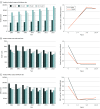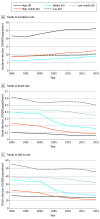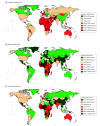Global, Regional, and National Epidemiology of Diabetes in Children From 1990 to 2019
- PMID: 37399036
- PMCID: PMC10318549
- DOI: 10.1001/jamapediatrics.2023.2029
Global, Regional, and National Epidemiology of Diabetes in Children From 1990 to 2019
Abstract
Importance: Diabetes in children is a global epidemic that causes various medical conditions associated with an increased incidence of premature death.
Objective: To investigate the trends in diabetes incidence, mortality, and disability-adjusted life-years (DALYs) in children, with risk factors for diabetes-associated death, from 1990 to 2019.
Design, setting, and participants: This was a cross-sectional study that used data from the Global Burden of Diseases (GBD) 2019 in 204 countries and territories. Children with diabetes who were aged 0 to 14 years were included in the analysis. Data were analyzed from December 28, 2022, to January 10, 2023.
Exposure: Childhood diabetes from 1990 to 2019.
Main outcome measures: Incidence, all-cause and cause-specific deaths, DALYs, and corresponding estimated annual percentage changes (EAPCs). These trends were stratified according to region, country, age, sex, and Sociodemographic Index (SDI).
Results: A total of 1 449 897 children (738 923 male [50.96%]) were included in the analysis. In 2019, there were 227 580 incident cases of childhood diabetes worldwide. Cases of childhood diabetes increased by 39.37% (95% uncertainty interval [UI], 30.99%-45.45%) from 1990 to 2019. Over 3 decades, diabetes-associated deaths decreased from 6719 (95% UI, 4823-8074) to 5390 (95% UI, 4450-6507). The global incidence rate increased from 9.31 (95% UI, 6.56-12.57) to 11.61 (95% UI, 7.98-15.98) per 100 000 population; however, the diabetes-associated death rate decreased from 0.38 (95% UI, 0.27-0.46) to 0.28 (95% UI, 0.23-0.33) per 100 000 population. Among the 5 SDI regions, the low SDI region had the highest childhood diabetes-associated mortality rate in 2019. Regionally, North Africa and the Middle East had the largest increase in incidence (EAPC, 2.06; 95% CI, 1.94-2.17). Among 204 countries, Finland had the highest national incidence of childhood diabetes in 2019 (31.60 per 100 000 population; 95% UI, 22.65-40.36), Bangladesh had the highest diabetes-associated mortality rate (1.16 per 100 000 population; 95% UI, 0.51-1.70), and the United Republic of Tanzania had the highest DALYs rate (100.16 per 100 000 population; 95% UI, 63.01-155.88). Globally, environmental/occupational risk, nonoptimal temperature, high temperature, and low temperature were key risk factors for childhood diabetes-associated mortality in 2019.
Conclusions and relevance: Childhood diabetes is an increasing global health challenge with rising incidence. Results of this cross-sectional study suggest that despite the global decline in deaths and DALYs, the number of deaths and DALYs remains high among children with diabetes, especially in low SDI regions. Improved understanding of the epidemiology of diabetes in children may facilitate prevention and control.
Conflict of interest statement
Figures




References
Publication types
MeSH terms
LinkOut - more resources
Full Text Sources
Medical

